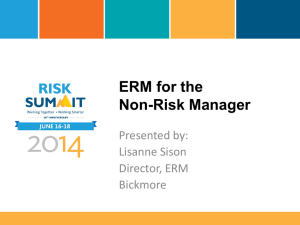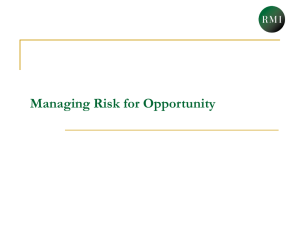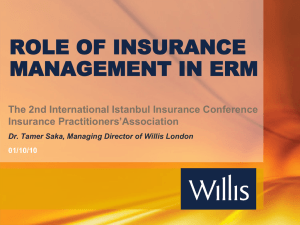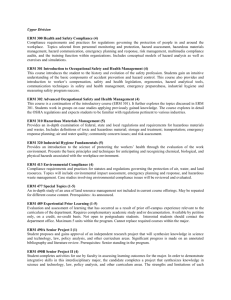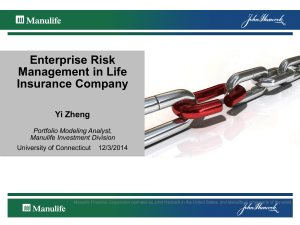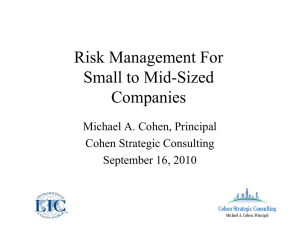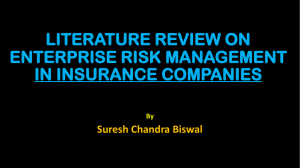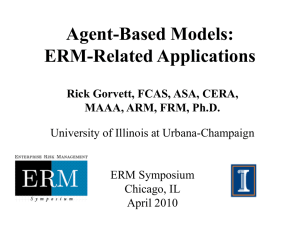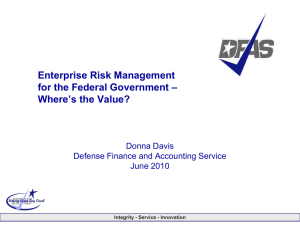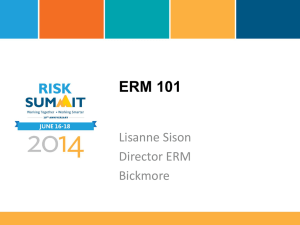Math 377 / 477 Casualty Actuarial Mathematics
advertisement
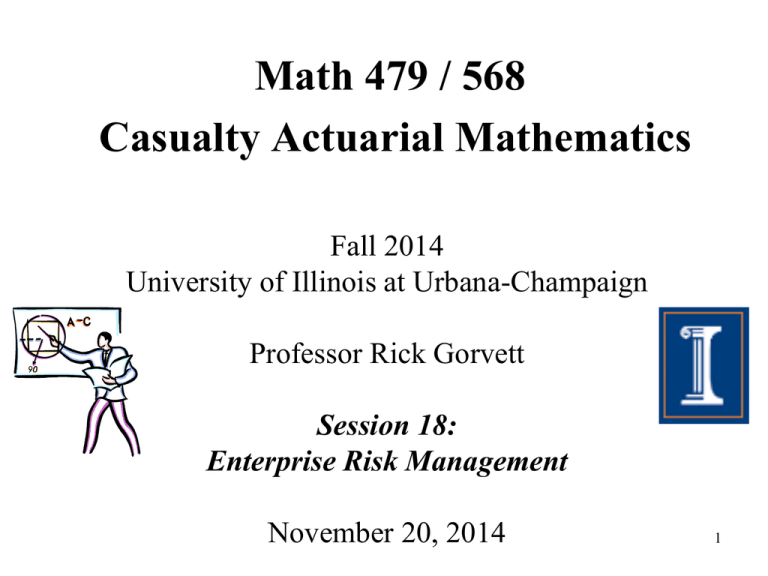
Math 479 / 568 Casualty Actuarial Mathematics Fall 2014 University of Illinois at Urbana-Champaign Professor Rick Gorvett Session 18: Enterprise Risk Management November 20, 2014 1 An Initial ERM Comment • You don’t become a famous writer by… – Reading a book – Reading about other authors – Watching someone else write • Similarly, you don’t become an “Enterprise Risk Manager” by… – Reading a book – Taking a course – Listening to a presentation 2 Rather, ERM is… A complex process… … involving broad-based and in-depth knowledge and understanding… … requiring an appropriate corporate culture,… … and creativity… … born of a variety of experiences… … and insatiable curiosity. 3 Enterprise Risk Management • Or “Enterprise Risk and Assurance Management” or… • What is ERM? – Concerned with a broad financial and operating perspective – Recognizes interdependencies among corporate, financial, and environmental factors – Strives to determine and implement an optimal strategy to achieve the primary objective: maximize the value of the firm Other Possible Goals of ERM • Create and increase company value • Ensure business continuity • Stabilize earnings • Enhance opportunities for the company to achieve its objectives • Make risk management more cost-efficient Evolution of ERM • Historically: “risk silo” mentality • Mid-1990s: – First “Chief Risk Officer” – First use of ERM terminology • Late-1990s: – Risk-related regulatory requirements (e.g., Turnbull) – Earnings protection insurance debuts • 2001: – September 11 – Corporate scandals – Beginning of efforts to improve corporate governance Current State • Findings from various surveys – An acknowledged need to improve risk management – A recognition that a holistic approach is appropriate and preferable – ERM can improve overall capital management and thus enhance corporate value and competitiveness – A variety of approaches to improving risk management – There are still problems to overcome A Paradigm Shift Traditional Emerging • Risks managed in silos • Concentrates on physical hazards and financial risks • Insurance orientation • Ad hoc / one-off projects • Centralized mgt., with exec-level coordination • Integrated consideration of all risks, firm-wide • Opportunities for hedging, diversification • Continuous and embedded Types of Risks • Operational – Hazard – Physical • Strategic – Capital / resource allocation – Industry / competitors • Technological – Databases – Security – Confidential information • Stakeholder • Legal – Compliance – Regulatory • Financial – Capital markets – Credit risks – Taxes • Human capital – Retention – Training • Reputational Issues in ERM Implementation • Different corporate cultures require different ERM approaches • Who is going to be the ERM champion within the company – Among senior executives – Among departments / functions • How to embed a risk management culture and responsibilities throughout the firm Components of the ERM Process • Determine corporate objectives Likelihood • Risk identification – Goal: comprehensiveness Impact – E.g., self-assessment – Volatility measures – Value at Risk (VaR) Likelihood • Risk measurement Size of loss Components of ERM (cont.) • Assessing the impact – Stress or scenario testing – Stochastic simulation • Examine and select alternative risk management tools and techniques – Traditional risk transfer – Natural hedging / diversification – Integration of risks E.g., “dynamic financial analysis” Components of ERM Copyright © 2004 by the Committee of Sponsoring Organizations of the Treadway Commission. Basel III, Solvency II, etc. • Regulations concerned with corporate management of risks • Three pillars of Solvency II: – Capital requirements for insurers – Framework for corporate governance and risk management – Reporting and disclosure requirements, transparency Keys to Success in ERM • Senior management commitment and sponsorship • Embed a “risk management culture” in the corporation at the operational level • Provide for accountability, both specific and widespread • Clearly defined responsibilities for coordination and maintenance • Adequate communication 15 ERM Tries to Avoid… “A failure of imagination.” - Frank Borman, in testimony to Congress, responding to a question regarding the real cause of the Apollo 1 fire and the resulting three astronaut deaths, as dramatized in HBO’s series From the Earth to the Moon 16 ERM Perspective: Steps in the ERM Process • • • • • • • Determine the corporation’s objectives Identify the risk exposures Quantify the exposures Assess the impact Examine alternative risk management tools Select appropriate risk management approach Implement and monitor program ERM Perspective: Risk Profile Legal Risks Hazard Risks Market Risk Operational Risks Firm Risk Financial Risks Strategic Risks Regulatory Risks Credit Risk Case Study: Honeywell • One of the first uses of integrated risk management • Mid-1990s: traditional risk management approach – Widely separated activities – Silo mentality: different areas / departments responsible for different risk exposures Honeywell (cont.) • Nature of the firm – Diversified technology and manufacturing company – Worldwide activities – Key businesses: • • • • Aerospace Automation and control Materials Transportation Honeywell (cont.) • In 1997, company considered a new risk management structure and approach • Old approach: – Separate annual insurance policies for each hazard risk (each with its own deductible) – Options to hedge FX risk • New approach: – Multiyear combined hazard-and-FX risk policy Honeywell (cont.) • Additional information: – Based on simulations of aggregate risk portfolio, a $30 million aggregate retention was proposed for the new policy Honeywell (cont.) • Question 1: – What do you think were some of the barriers that Honeywell might have faced in switching to the proposed multi-year, multi-line policy? How might each of these barriers been addressed or overcome? Honeywell (cont.) • Question 2: – Does this new, proposed policy “add value” to Honeywell? If so, how? • Question 3: – Why might the proposed, bundled policy be less costly to Honeywell than the aggregate costs associated with the unbundled risks? The Challenge of ERM – Beyond Honeywell • “The Honeywell integrated insurance policy is a first step, but a true integrated risk management strategy must go beyond the scope of the Honeywell contract: It must incorporate more of the firm’s risks, shift the analysis from tactical to strategic, and evaluate how the other ways to manage risk… should be used.” – Lisa Meulbroek, 2002, “The Promise and Challenge of Integrated Risk Management,” Risk Management and Insurance Review, Vol. 5, No. 1, 55-66. UGG Case Study • In 1999, a $200+ million (Canadian) revenue firm, headquartered in Winnipeg, Manitoba • Originally a farmer cooperative • Business segments: – – – – Grain handling Crop production Livestock Business communications UGG (cont.) • Risk management committee + Willis identified 47 areas of exposure • Six key risks analyzed further: – – – – – – Environmental liability Weather Counterparty Credit Commodity Inventory UGG (cont.) • Analysis of each key risk – Probability distributions of losses – Impact on financial / corporate measures of interest • Main concern: weather risk • Regressions of crop yields against temperature and precipitation UGG (cont.) • Questions in case study – 1 and 2: impact of ownership structure – 3: constructing a weather derivative – 4: constructing an insurance contract – 5: integration with other risks and coverages – 6: insurance versus derivative – 7: loss control measures


